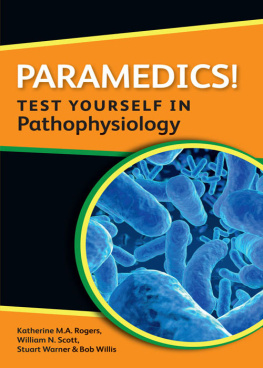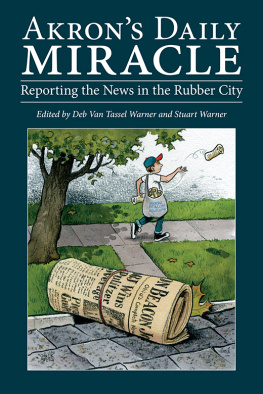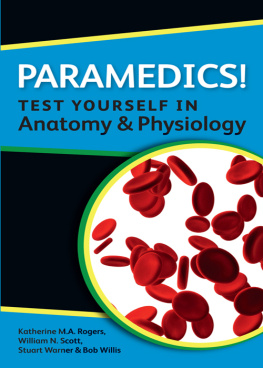Paramedics! Test Yourself in Pathophysiology
Katherine M.A. Rogers, William N. Scott, Stuart Warner and Bob Willis

Open University Press
McGraw-Hill Education
McGraw-Hill House
Shoppenhangers Road
Maidenhead
Berkshire
England
SL6 2QL
email: enquiries@openup.co.uk
world wide web: www.openup.co.uk
and Two Penn Plaza, New York, NY 101212289, USA
First published 2011
Copyright Katherine M. A. Rogers, William N. Scott, Stuart Warner and Bob Willis 2011
All rights reserved. Except for the quotation of short passages for the purposes of criticism and review, no part of this publication may be reproduced, stored in a retrieval system, or transmitted, in any form or by any means, electronic, mechanical, photocopying, recording or otherwise, without the prior written permission of the publisher or a licence from the Copyright Licensing Agency Limited. Details of such licences (for reprographic reproduction) may be obtained from the Copyright Licensing Agency Ltd of Saffron House, 610 Kirby Street, London, EC1N 8TS.
A catalogue record of this book is available from the British Library
ISBN-13: 9780335244515
ISBN-10: 0335244513
eISBN: 9780335244522
Library of Congress Cataloging-in-Publication Data
CIP data applied for
Illustrations by Gary Holmes
Typeset by RefineCatch Limited, Bungay, Suffolk
Printed in the UK by Bell & Bain Ltd, Glasgow.
Fictitious names of companies, products, people, characters and/or data that may be used herein (in case studies or in examples) are not intended to represent any real individual, company, product or event.
Contents
8 The respiratory system
INTRODUCTION
Welcome to Paramedics! Test Yourself in Pathophysiology. We hope you will find this an invaluable tool throughout your pathophysiology course and beyond!
This book is designed to be used as a revision aid that you can use with your main textbook. Each chapter is designed for stand-alone revision, meaning that you dont have to read from the beginning to benefit from the book you can dip in and out as you need to.
Every chapter begins with a brief introduction covering the main points of the topic and directing you to some useful resources. The chapter progresses providing you with different types of questions that help you test your knowledge of the area.
These are:
Labelling Exercise: identify the different elements on the diagram.
True or False: identify if the statement is true or false.
Multiple Choice: identify which of four answers is correct.
Fill in the Blanks: fill in the blanks to complete the statement.
Match the Terms: identify which term matches which statement.
The questions have been designed to be slightly more challenging in each section. Do not ignore a question type just because you are not tested in that way because the answer contains useful information that could easily be examined in an alternative question format. Answers are provided in each chapter with detailed explanations this is to help you with revision but can also be used as a learning aid.
We have suggested some useful textbooks that may be used to support your recommended text, but be aware that they should not replace the core reading for your course.
A list of common abbreviations used throughout the book and a list of common prefixes, suffixes and word roots commonly used in pathophysiology are provided. At the back there is a glossary.
We hope that you enjoy using this book and that you find it a convenient and useful tool throughout your paramedic studies!
GUIDE TO TEXTBOOK RESOURCES
Paramedics! Test Yourself in Anatomy and Physiology
Katherine M. A. Rogers, William N. Scott, Stuart Warner and Bob Willis
Published by McGraw-Hill, 2011
Essentials of Pathophysiology: Concepts of Altered Health States
(3rd international edition)
Published by Lippincott Williams & Wilkins, 2010
Fluids and Electrolytes Made Incredibly Easy
William N. Scott
Published by Lippincott Williams & Wilkins, 2010
Ross and Wilsons Anatomy and Physiology in Health and Illness (11th edition)
Anne Waugh and Allison Grant
Published by Churchill Livingstone, Elsevier, 2010
Symptoms, Diagnosis and Treatment: A Guide for Pharmacists and Nurses
Paul Rutter
Published by Churchill Livingstone, Elsevier, 2005
These are common abbreviations used in the clinical setting and throughout this book.
| ABG | arterial blood gas |
| ACE | angiotensin-converting enzyme |
| ACS | acute coronary syndrome |
| ADH | antidiuretic hormone (or vasopressin) |
| AIDS | acquired immune deficiency syndrome |
| ALL | acute lymphocytic leukaemia |
| AMI | acute myocardial infarction |
| AML | acute myeloid leukaemia |
| ASD | autistic spectrum disorders |
| AST | aspartate aminotransferase |
| BP | blood pressure |
| BUN | blood urea nitrogen |
| CAD | coronary artery disease |
| CF | cystic fibrosis |
| CK | creatinine kinase |
| CKD | chronic kidney disease (end-stage renal disease) |
| CLL | chronic lymphocytic leukaemia |
| CML | chronic myeloid leukaemia |
| CO2 | carbon dioxide |
| COPD | chronic obstructive pulmonary disorders (or diseases) |
| CPP | cerebral perfusion pressure |
| CRF | chronic renal failure |
| CSF | cerebrospinal fluid |
| CT | computerized tomography |
| CTS | carpal tunnel syndrome |
| CVA | cerebrovascular accident (or stroke) |
| CVD | cardiovascular disease |
| CVE | cerebrovascular emergency (or stroke) |
| CVS | chorionic villus sampling |
| DEXA | dual energy X-ray absorptiometry |
| DI | diabetes insipidus |
| DKA | diabetic ketoacidosis |
| DM | diabetes mellitus |
| DRE | digital rectal examination |
| DVT | deep vein thrombosis |
| ECG | electrocardiogram |
| EEG | electroencephalogram |
| EMG | electromyography |
| ERCP | endoscopic retrograde cholangio-pancreatography |
| ESWL | extracorporeal shock wave lithotripsy |
| ETCO2 | end-tidal carbon dioxide |
| FBAO | foreign body airway obstruction |
| FH | familial hypercholesterolaemia |
| GCS | Glasgow Coma Scale |
| GFR | glomerular filtration rate |
| GI | gastrointestinal |
| GP | general practitioner |
| GTN | glyceryl trinitrate |
| HDL | high-density lipoprotein |
| HDU | high dependency unit |
| HIV | human immunodeficiency virus |
| HNPCC | hereditary non-polyposis colorectal cancer |
| HPV | human papilloma virus |






